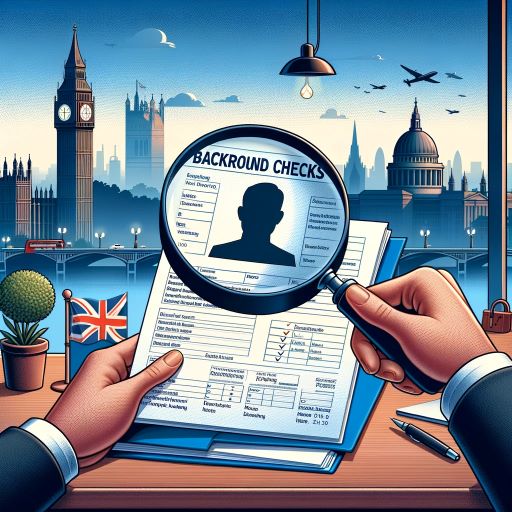

• Reveal both spent and unspent convictions, cautions, reprimands, and final warnings, offering a more detailed insight into an applicant's background.
6. Enhanced DBS Checks:
• Include local police details relevant to the role, giving employers a thorough understanding of any potential risks associated with the candidate.
Initiating the DBS checks application process requires providing essential identity and address proof for Basic checks. For Standard and Enhanced checks, additional documentation is necessary. Remember, individuals can only request basic DBS checks for themselves. Once the application is submitted, employers need to authenticate the received certificate. The processing duration varies: Basic, Standard, and Enhanced DBS checks typically take 1 to 14 days.
Application Process Steps Required Documentation Applicant Type
Step 1 Identity verification (e.g., passport) Individual Applicant
In the UK, the duration of pre-employment screening checks can vary significantly depending on the type and depth of the checks being conducted, as well as the industry and specific job role requirements. Generally, basic checks, such as identity verification and employment history, can be completed within a few days to a week. More comprehensive checks, including criminal record checks (DBS checks), credit history, and higher-level security clearances, may take longer.
An employee background check can encompass a wide range of verifications and screenings to assess a candidate's history and suitability for a position. The specific elements included in a background check may vary depending on the job, the industry, and the employer's requirements. Common components of an employee background check include:
Identity Verification: Confirms the candidate's identity through government-issued documents like passports or driver's licenses.
Employment History Verification: Checks the candidate's previous employment, including positions held, dates of employment, reasons for leaving, and rehire eligibility.
Education Verification: Confirms the candidate's educational degrees, diplomas, and certificates from colleges, universities, and other educational institutions.
Criminal Record Check: Searches for any criminal convictions, cautions, reprimands, or warnings. In some countries, this is known as a Disclosure and Barring Service (DBS) check in the UK or a criminal background check in the US.
Credit History Check: Reviews the candidate's credit history, which can be relevant for positions involving financial responsibilities. This check typically includes looking at credit scores, outstanding debts, bankruptcies, and financial mismanagement.
Reference Checks: Involves contacting previous employers, colleagues, or academic references to gain insights into the candidate's work ethic, abilities, and behavior.
Step 2 Address verification (e.g., utility bill) Individual Applicant
Step 3 Additional documents for Standard/Enhanced checks Individual Applicant
Step 4 Review and submission Employer

To ensure successful preemployment screening, it's essential to avoid common mistakes when conducting DBS checks. Here are some key pitfalls to avoid:
7. Failure to Verify DBS Certificate Authenticity: Skipping the verification of a DBS certificate's authenticity could result in hiring unsuitable candidates with false credentials.
8. Misunderstanding Spent vs. Unspent Convictions: Not grasping the distinction between spent and unspent convictions might lead to making incorrect hiring choices based on outdated information.
9. Neglecting Specific DBS Check Requirements: Overlooking the need for particular types of DBS checks tailored to certain roles can expose organizatiog successful preemployment screening by avoiding common errors with DBS checks, comprehending the stages of the DBS checking process is esns to legal liabilities and risks associated with inadequate background screening.
Moving seamlessly from ensurinsential for effectively evaluating candidates for suitability and safety.
The process typically begins with applicants submitting their information and necessary documentation. Subsequently, the Disclosure and Barring Service conducts checks with relevant databases to identify any criminal records or cautions tied to the individual.

Once this verification phase is complete, the DBS issues the appropriate certificate based on the disclosed information. Employers play a vital role in ensuring the authenticity of the DBS certificate before making informed decisions about the candidate's suitability for the role.
Evaluating candidates through preemployment screening plays a pivotal role in helping organizations make informed hiring decisions and maintaining a safe working environment. By conducting thorough screenings, employers can:
10. Identify Suitability: Screening processes like criminal record checks and reference verifications help mitigate risks and ensure that candidates are fitting for the role they're being considered for, reducing the chances of potential misconduct or harm in the workplace.
11. Safeguard the Organization: Avoiding unsuitable hires through preemployment checks can lead to improved retention rates and cost reduction. It helps in maintaining a positive work environment and reducing the likelihood of workplace conflicts or legal issues.
12. Ensure Compliance: Legal requirements, such as righttowork checks, guarantee compliance and help organizations avoid legal consequences. Adhering to these regulations not only protects the organization from penalties but also fosters a culture of integrity and responsibility within the workplace.
For effective preemployment screening, employers must meticulously follow the guidelines provided for conducting Disclosure and Barring Service (DBS) checks. When carrying out Basic DBS checks, it's crucial to validate the identity and address of candidates.
